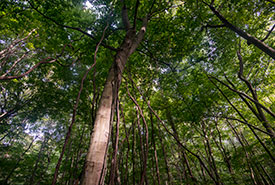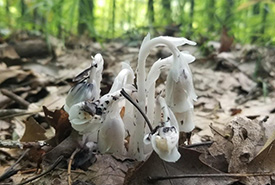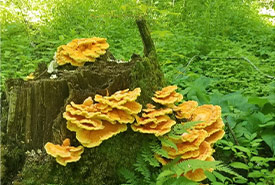A throwback to working in Backus Woods

Forest canopy in Backus Woods (Photo by Neil Ever Osborne)
I had the pleasure of working for the Nature Conservancy of Canada (NCC) for the summer of 2019 as a conservation technician out of the Norfolk County, Ontario, office. When I first came to Norfolk, I was expecting to see mostly farmland and fields with a few plantations. But I was surprised to find lots of forest cover. One of these forested areas is NCC’s Backus Woods.
I had previously spent a lot of time in forests while I was a student at Sault College and now Lakehead University; mind you, these were in the boreal forest and Great Lakes–St. Lawrence forests, but I thought I had seen both big and old trees. However, the first time I stepped into Backus Woods, I was dumbfounded! I had never seen such large and old trees in my life. This was the moment when I realized that Backus Woods is a unique and special forest that needs to be protected.

Ghost pipe (Photo by NCC)
Backus Woods is an older-growth Carolinian forest that is home to many rare and at-risk species, as well as a number of abundant but equally interesting species, such as ghost pipe and chicken of the woods mushroom.
It is evident how this kind of older-growth forest benefits wildlife and plants; you can see it in the diversity from the forest floor to the tops of the trees. One abundant resource that is very apparent when you walk through Backus Woods is the dead, standing trees. These trees, usually marked with many holes in their trunks excavated by woodpeckers, provide shelter and food for other wildlife. Even after these dead trees fall to the forest floor, they still provide resources to wildlife and plants, with saplings and moss growing on top of the trees and insects sheltering and foraging under its bark.
Related blog posts
Some of the tasks I completed in the summer of 2019 while working for NCC to help protect and manage such a forest might seem small, but they were not easy. I assisted with trail maintenance, invasive species control, property management plan updating and surveys for species at risk. These involved long days working in hot weather and in areas teeming with insects. They also required lots of hiking, learning about new species and acquiring new skills. These tasks were much harder than they sound, but even the little actions can have huge rewards.
Each of these tasks ultimately helped with the protection and conservation of Backus Woods. While updating a property management plan, I and conservation staff in Norfolk looked for and recorded any dump sites that needed to be cleaned up, searched for rare and at-risk species and classified the different types of forest present to better plan its management in the future. All this work is crucial for the long-term management of Backus Woods.

Chicken of the woods mushrooms (Photo by NCC)
I think the trail maintenance that I completed is very important, as it will allow nature lovers (including myself) to explore this amazing location with ease. Clearing and maintaining trails is also helpful for protecting both plants and animals because it prevents people from stepping on plants and disturbing the wildlife that lives in Backus Woods.
With Backus Woods being such an old and awe-inspiring forest, I realized that without the help of our donors, partners, the community and NCC staff, this forest might have been lost forever. With an amazing network of trails and interpretive signs throughout the property, Backus Woods is a great place for the whole family to learn about nature and see an amazing example of older-growth Carolinian forest. When you visit, though, don’t forget to bring bug spray!
NCC has been caring for Backus Woods since 2011 and enhancing this unique habitat and beloved conservation destination ever since, thanks to the generous support of The W. Garfield Weston Foundation, TD Bank Group through the TD Forests Program and the Government of Canada through the former Natural Areas Conservation Program.




